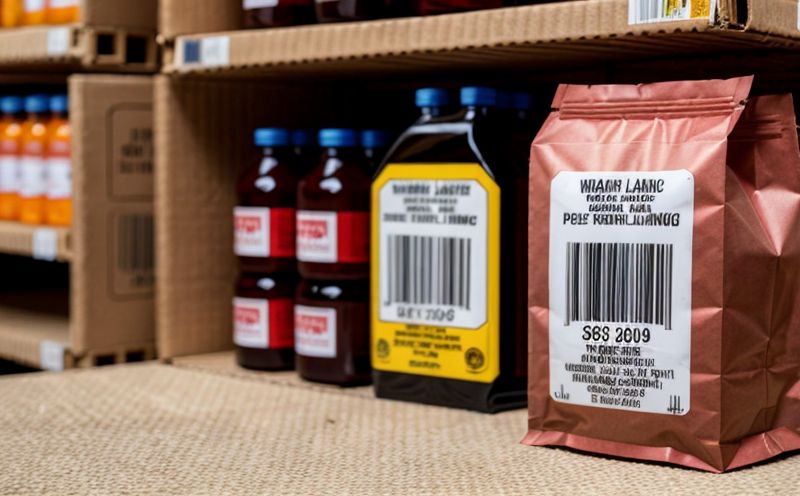ISO 17351 Braille Labeling for Accessible Packaging Test
The ISO 17351 standard ensures that braille labeling on packaging is accessible to the visually impaired, promoting inclusivity and safety in the toy industry. This service focuses on testing whether the braille labels meet the stringent requirements set by this international standard.
ISO 17351 requires that all important information about a product be presented in braille, ensuring that visually impaired individuals can read it without assistance. The standard covers various aspects of braille labeling, including font size, spacing between characters, and tactile quality. Proper implementation is essential to ensure the labels are legible under different conditions.
Our service involves several steps: first, we prepare a sample package according to the requirements specified in ISO 17351. This includes ensuring that the braille label meets the size and spacing criteria set by the standard. Once the package is prepared, it undergoes rigorous testing using tactile inspection tools designed specifically for this purpose.
The testing process checks several key parameters: font size, character height, letter depth, and overall clarity of the braille characters. These tests are crucial to ensure that visually impaired individuals can read the labels accurately. Additionally, our service includes environmental stress testing, which simulates real-world conditions such as temperature changes, humidity levels, and exposure to sunlight.
Our state-of-the-art facilities use specialized equipment to perform these tests. Our technicians have extensive experience in conducting ISO 17351-compliant tests and are well-versed in the nuances of this standard. They can provide detailed insights into any discrepancies found during testing, offering solutions for improvement.
The importance of ISO 17351 cannot be overstated, especially given the diverse needs of visually impaired consumers. By ensuring compliance with this standard, toy manufacturers demonstrate their commitment to inclusivity and safety. Our service not only helps toys meet regulatory requirements but also enhances brand reputation by showcasing a dedication to accessibility.
Compliance with ISO 17351 is critical for brands aiming to reach a broad audience, including those who rely on braille labels for product information. This standard ensures that all necessary details are presented in an accessible manner, fostering trust and confidence among consumers.
In conclusion, our ISO 17351 Braille Labeling for Accessible Packaging Test service plays a pivotal role in promoting inclusivity and safety within the toy industry. By adhering to this international standard, manufacturers can ensure that their products are accessible to all users, including those with visual impairments.
Benefits
Compliance with ISO 17351 is a significant advantage for toy manufacturers. It ensures that the braille labeling on packaging meets international standards, thereby enhancing product safety and accessibility. This compliance also boosts brand reputation by demonstrating a commitment to inclusivity.
- Ensures compliance with international standards
- Promotes inclusivity and safety in the toy industry
- Enhances brand reputation through adherence to best practices
- Aids in meeting regulatory requirements
- Provides detailed insights into any discrepancies found during testing
- Offers solutions for improvement based on test results
By offering this service, we help toy manufacturers navigate the complexities of international standards and ensure that their products are accessible to all users.
Industry Applications
| Application | Description |
|---|---|
| Braille Labeling for Packaging | This application focuses on ensuring that braille labels are correctly implemented and meet the requirements set by ISO 17351. It includes testing font size, character height, letter depth, and overall clarity. |
| Environmental Stress Testing | This involves simulating real-world conditions to test the durability of braille labels under various environmental factors such as temperature changes, humidity levels, and exposure to sunlight. |
- Preparation of sample package according to ISO 17351 requirements
- Tactile inspection using specialized equipment
- Rigorous testing of braille labels' parameters
- Environmental stress testing for durability assessment
These applications are crucial in ensuring that toy packaging is accessible and safe for all users, including those with visual impairments.
Environmental and Sustainability Contributions
Incorporating ISO 17351-compliant braille labeling into toy packaging can contribute positively to environmental sustainability. By ensuring that all necessary information is accessible, manufacturers reduce the likelihood of accidents or misunderstandings due to missing labels.
This standard encourages thoughtful design and production practices that prioritize safety and accessibility. It also promotes a culture of inclusivity within the industry, encouraging brands to consider diverse user needs.
The use of ISO 17351 in toy packaging can lead to reduced waste and increased product longevity. By ensuring that all necessary information is accessible from the start, manufacturers can avoid the need for additional labeling or rework, which often leads to unnecessary waste.
Our service not only helps toy manufacturers comply with international standards but also supports their efforts towards environmental sustainability by promoting thoughtful design practices. This aligns with broader industry trends toward more sustainable and inclusive manufacturing processes.





